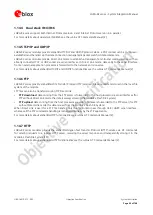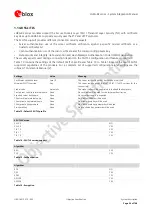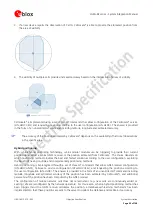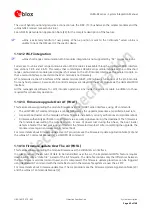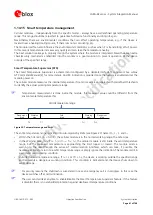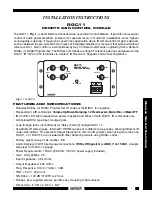
LARA-R2 series - System Integration Manual
UBX-16010573 - R02
Objective Specification
System description
Page 46 of 148
1.9.2
USB interface
1.9.2.1
USB features
LARA-R2 series modules include a High-Speed USB 2.0 compliant interface with 480 Mb/s maximum data rate,
representing the main interface for transferring high speed data with a host application processor, supporting:
AT command mode
12
Data mode and Online command mode
FW upgrades by means of the FOAT feature (see 1.14.13 and
Firmware update application note
FW upgrades by means of the u-blox EasyFlash tool (see the
Firmware update application note
Trace log capture (diagnostic purpose)
The module itself acts as a USB device and can be connected to a USB host such as a Personal Computer or an
embedded application microprocessor equipped with compatible drivers.
The
USB_D+
/
USB_D-
lines carry USB serial bus data and signaling according to the
Universal Serial Bus Revision
2.0 specification
[9], while the
VUSB_DET
input pin senses the VBUS USB supply presence (nominally 5 V at the
source) to detect the host connection and enable the interface.
The USB interface of the module is enabled only if a valid voltage is detected by the
VUSB_DET
input (see the
LARA-R2 series
[1]). Neither the USB interface, nor the whole module is supplied by the
VUSB_DET
input: the
VUSB_DET
senses the USB supply voltage and absorbs few microamperes.
The USB interface is controlled and operated with:
AT commands according to
3GPP TS 27.007
3GPP TS 27.005
u-blox AT commands (for the complete list and syntax see the
u-blox AT Commands Manual
The USB interface of LARA-R2 series modules, according to the configured USB profile, can provide different USB
functions with various capabilities and purposes, such as:
CDC-ACM for AT commands and data communication
CDC-ACM for GNSS tunneling
CDC-ACM for SAP (SIM Access Profile)
CDC-ACM for Diagnostic log
CDC-NCM for Ethernet-over-USB
CDC-ACM for GNSS tunneling, CDC-ACM for SAP, and CDC-NCM for Ethernet-over-USB are not
supported by “02” product versions.
The USB profile of LARA-R2 series modules identifies itself by its VID (Vendor ID) and PID (Product ID)
combination, included in the USB device descriptor according to the
USB 2.0 specification
If the USB is connected to the host before the module is switched on, or if the module is reset (rebooted) with
the USB connected to the host, the VID and PID are automatically updated during the boot of the module. First,
VID and PID are the following:
VID = 0x8087
PID = 0x0716
This VID and PID combination identifies a USB profile where no USB function described above is available: AT
commands must not be sent to the module over the USB profile identified by this VID and PID combination.
12
See the
u-blox AT Commands Manual
[2] for the definition of the command mode, data mode, and online command mode.
























